I’ve just updated our Etsy shop with yarn and roving from the flock. We have 100% Shetland and Shetland/Llama blends available. Get it here.

I’ve just updated our Etsy shop with yarn and roving from the flock. We have 100% Shetland and Shetland/Llama blends available. Get it here.


After lots of rain and sun this summer, the grass in our pastures is growing tall and thick. Which isn’t something I’ll ever complain about (it sure beats the alternative) but it is a bit of a problem. Our herd of 14 goats is barely making a dent on the 5 acre portion that they are on, and the other two sections are just getting taller by the day. If we don’t do something the grass will die back in the winter and form a matted mess that is difficult for the new growth to break through next spring. Really tall grass also attracts and supports a lot of bugs, including those that bite and suck on both livestock and people. Plus it looks really bad and over grown. We considered having someone come out and harvest it for hay but its not really the proper type of grass for hay (its mostly bahia which is better for grazing than for haying, or so I’ve been told). We considered just hiring someone to mow it all down but a) that seems very wasteful b) I worry that the dead grass left in the fields will kill the grass that it covers, leaving us with bare spots and c) it isn’t a very sustainable solution since it should be done twice a year and would cost several hundred dollars each time.
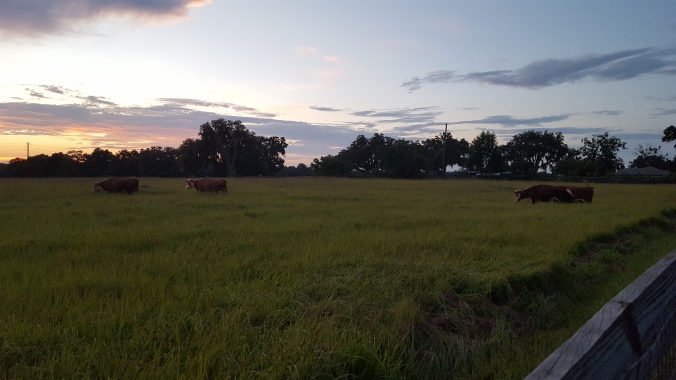
We opted for a much more fun solution- – we are borrowing cows! While looking for advice on a online farming forum we got in touch with someone in the area who has a small herd of mini Hereford cows and not enough pasture for them. Instead of pouring expensive feed into them every day, he’d much rather have them eating grass. And I’d love to have them eating OUR grass. Cows are, from what I’ve heard, the best animal for maintaining pastures because they eat a lot of grass (unlike the goats) and are gentle grazers and don’t pull the grass up by its roots (like horses).

We now have 4 mini herefords (3 cows and a bull) and a young belted galloway steer in the front pasture. I have no idea how long it will take them to get the grass under control but once its a length we like we will swap them with the goats in the back pasture. We may even fix the broken fencing in the smaller front pasture and let them get it under control for us too. And the best part is, once we run out of pasture we will just send them home! Plus, I think they are pretty cute…


Spent all afternoon yesterday consulting with a vet and still don’t have a firm diagnosis, but it seems that some type of biting insect has been attacking the goats. Not sure what type, but its not something that lives on the skin or lays eggs/larva in the skin (so not mites, lice or bot fly). Its bad enough on a couple of the girls that they are getting 2-weeks of injectable antibiotics.
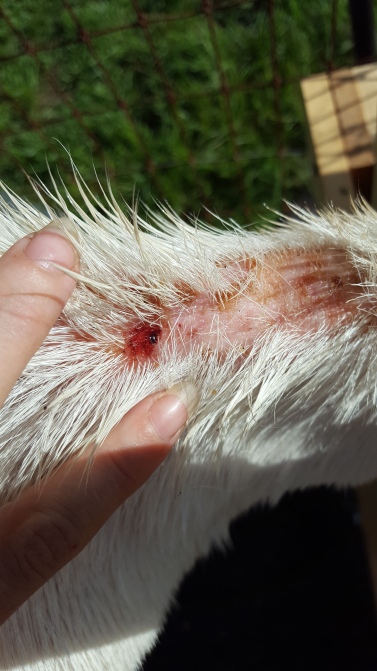
The good news is that the vet confirmed that even with the hot, damp weather we’ve been experiencing none of the Kikos are showing signs of heavy worm loads– bright pink eyelids and dark red blood mean that they aren’t anemic one bit. No sign of hoof rot, another warm/wet weather problem, either. 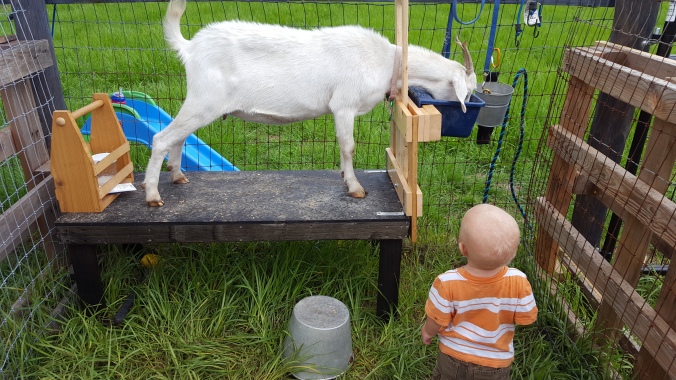
Nelly, our milk goat, is still struggling with worms but that isn’t a surprise- I think she has had them since I got her. We dewormed her again (Cydectin) and took a fecal and will re-test in 2 weeks. She also got a mineral shot and new diet regime and will be getting the daily antibiotics. Hopefully the combination of these things will help her put on weight and get healthy. I’d like to breed her with everyone else later this summer but she needs to get healthy first. I’m posting a couple of photos of skinny Nelly below so I can compare them to how she looks in a few weeks. Hopefully there will a noticeable difference! 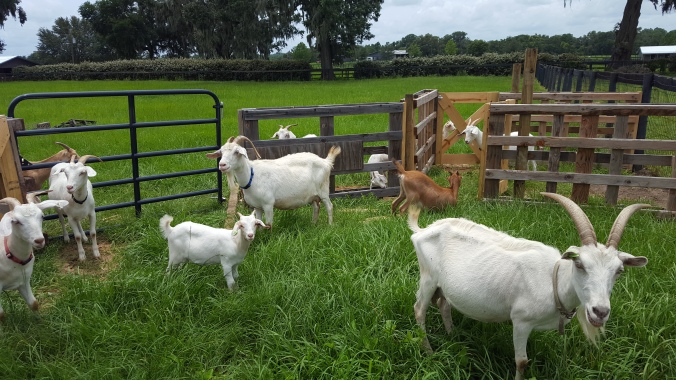
$125
Born 3-18-17 as a set of triplets. Raised on pasture at dam’s side. Has not been medicated but can be given CDT and dewormer prior to pickup if buyer prefers.
Mom is registered Saanan dairy goat. Dad is 100% registered boer.
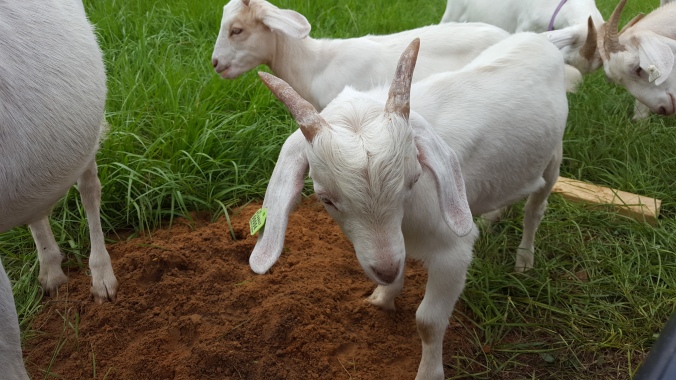
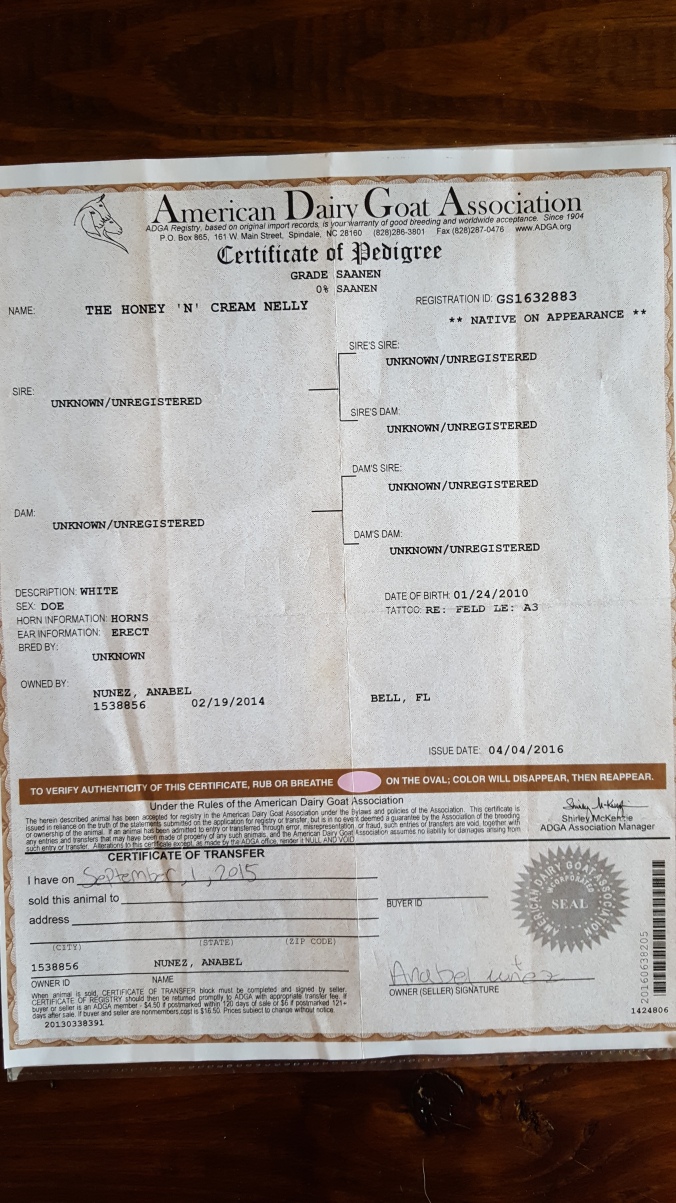


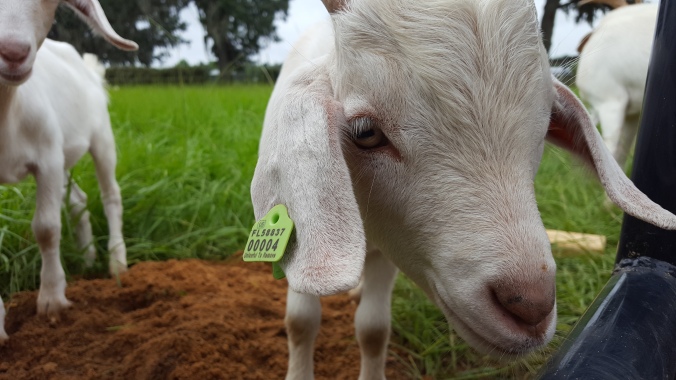

After the difficulties we had last summer with our pasture we have been slow to add new livestock to the farm. After clearing out all the toxic perilla mint we could find last fall, we got one new goat, named her Hope and hoped for the best. Not only did she survive but she surprised us with a healthy kid early this spring! We suspect she probably get in with a buck while she was at the livestock auction where we bought her. Feeling hopeful, we decided to bite the bullet and buy more goats.
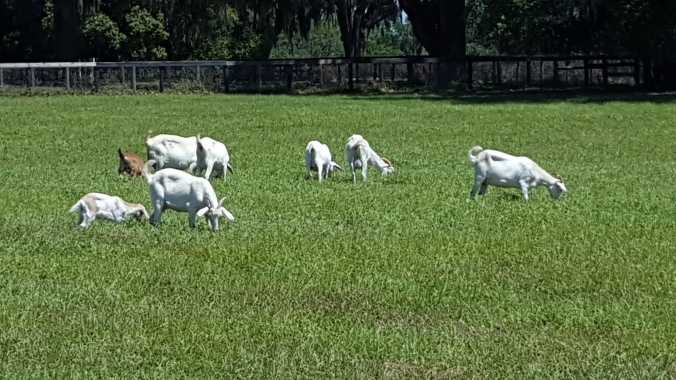
On April 6th we brought in 6 Kiko does and 2 doelings. These ladies will, hopefully, be the matriarchs of a herd of meat goats. The plan is to use them for breeding and sell the offspring. I’ll be adding a buck to the herd later this summer. All of the does kidded in February or March so I want to give them at least one or two more months off before breeding them again. Right now I’m thinking of using a Boer buck so that the kids have more of the traditional boer “look” that most buyers around here are accustomed to. I’m using Kikos as the does, though, because they have much better maternal instincts and abilities than boers and are generally much hardier goats an easier keepers. Since I need lots of does and only one buck, I’d rather have lots of easy keeping Kikos and only one delicate Boer.
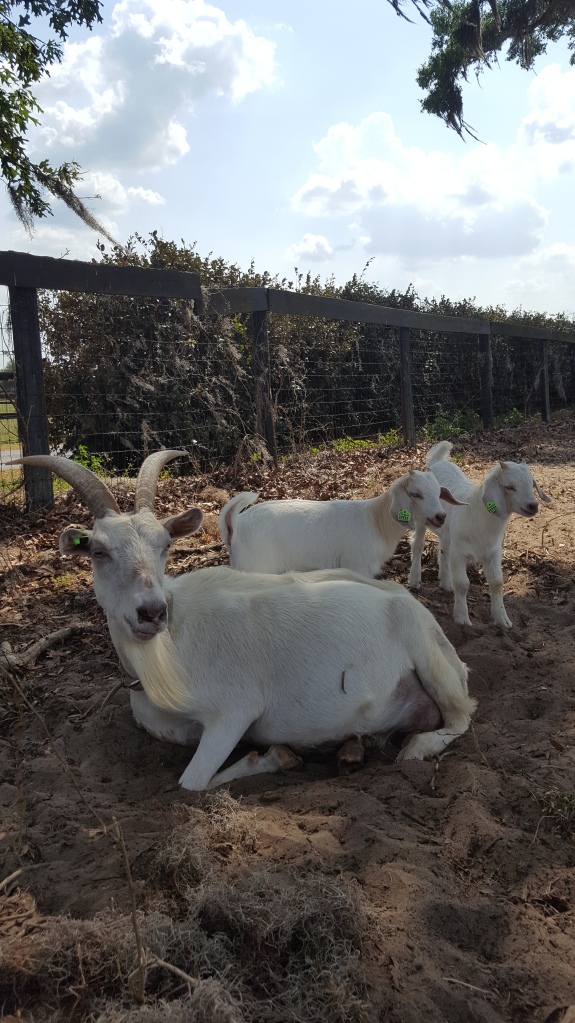
Of course, I can’t have a herd of goats without having at least one dairy goat. I miss all the fresh cheese and icecream! So on April 28 I added Nelly, a Saanen dairy goat, and her two kids (one male, one female). The kids are half boer so they will probably go to market, but I could potentially keep the doeling as a second dairy goat. Saanens are big framed goats and can easily handle being bred to boers so in addition to hopefully being a good source of milk, Nelly can also serve as a breeding doe for market kids. She was given a dewormer a month ago that can get into the milk so I’m not supposed to milk her for a few more days (its fine for her kids to drink but humans aren’t supposed to drink it), but fingers crossed that she is as good a milker as her previous owner promises!
Mom visited this week and helped get the gardens weeded, fertilized with llama pellets and planted with fall veggies.
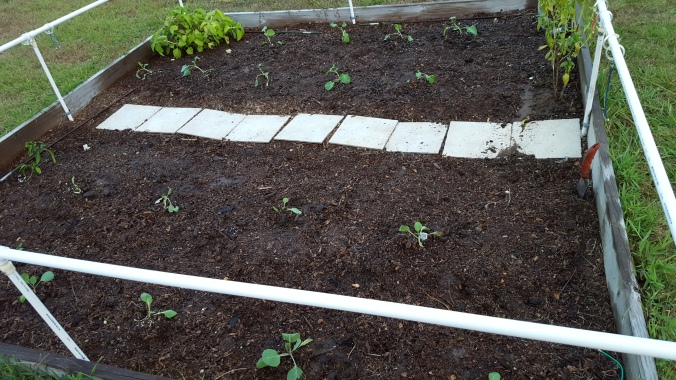
Broccoli and cabbage plants with onions in between the rows (not yet sprouted). Summer’s basil struggling in one corner and Cuban oregano thriving in the other.
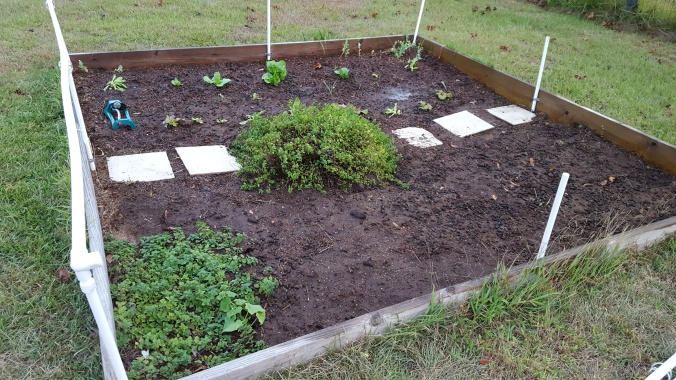
Assorted lettuce in the back with garlic beginning to come up between the rows. Patches of thyme and oregano. Newly planted in the front: beets, carrots and onions.

Nothing new in the pineapple and yucca garden, but now that the weeds are gone you can see how many pineapple plants we have!

The final garden still has some weeds hiding under the cardboard. Hopefully we will get this one finished over Thanksgiving!
If you’ve been following my blog you know that I recently had a devastating loss of nearly my entire flock of sheep and goat, all due to a toxic plant called Perilla Frutescens. You can read about my story here, but this post is going to be an informational PSA. There will be some graphic images at the end. If you have any experience with Perilla please comment on this post or email me at squarepegfarmfl@gmail.com

Perilla Mint- also called Shiso, Beefsteak Plant and by other regional names- is a non native invasive that is grown as a culinary herb or by permaculture gardeners. As a member of the mint family it has the characteristic square stem, extensive underground root system and minty smell. The smell is more earthy and less sharp than a peppermint or spearmint, but still distinctly minty. The leaves are more broad than most mints and it can be confused for a member of the basil family (if you aren’t sure, smell it– it smells like mint, not basil!) Perilla comes in green or purple. The variety that is on my property is green, but you can see pictures the purple variety here.
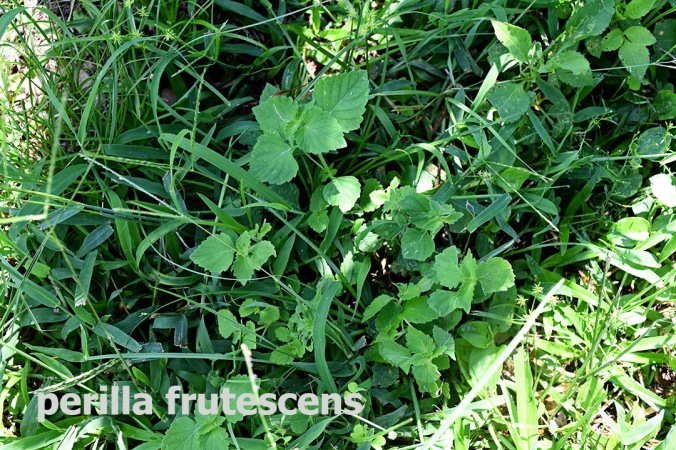
Most information I’ve found about Perilla says that livestock will not eat it unless they are desperate.. Do not let this make you complacent about the dangers of this plant!!
If your animals have not been exposed to perilla before and are introduced to it either due to a move to a new pasture or to the plant spreading to your property then they may not know to avoid it. In fact, they may actually seek out its minty flavor. My flock actively hunted for it, ignoring the plentiful grass and other forage in favor of perilla.
If you have always had perilla in your pasture you may think that you are safe because your animals have ignored it in the past. Unfortunately that is not true. If we have a particularly hot or dry summer your regular pasture forage may get crispy and unappetizing. Perilla doesn’t require much water so it will remain lush and green, inviting your animals to give it try. Because Perilla kills so quickly and there is no treatment, you may not have any warning or get a second chance.
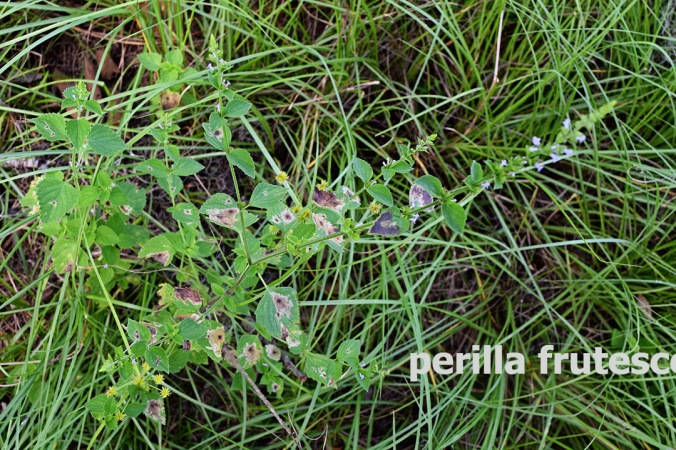
Identification

Toxicity
Where to Find It
I know for sure that perilla can be found in pastures throughout the southeast US from Tennessee to Florida. If you have seen it growing wild in other areas please let me know!
When looking around your property pay special attention to fence lines and shady areas. You can practically map the spread of perilla in one of my pastures by looking at the shade cast by the trees running down the fenceline.
Also keep an eye on any newly disturbed areas. A neighbor of mine just discovered several plants growing in an area where she recently lost a tree. Remember that even if you haven’t seen it in the past, any changes to the land could provide an opening for it.
Update: after posting this people have let me know that they have found perilla growing wild in the following states: FL, AR, NC, KY, CA
Keep in mind that these are observations of individuals who are not professional botanists and Perilla can be confused with other wild mints. However if you live in one of these states and find a plant in your pasture that might be perilla, its certainly worth a closer look!

Next Steps
If you find Perilla on your property what do you do next?

Dead perilla all down the fenceline after spraying
Prevention
I’m still researching this and would appreciate any advice or links to additional resources. From what I’ve learned you can keep it from taking over by mowing before it goes to seed, however it grows so quickly that I wouldn’t risk keeping animals on a pasture that has had perilla mowed down since while this might prevent it from spreading it won’t kill what is already there. I’m also hesitant to recommend keeping it mowed short because it opens your pasture up to creeping indigo, which will only survive in short grass. In order to prevent CI from coming in where the perilla used to be, I’m planning to plant a fast growing cover crop anywhere we clear.
If you have any experience with Perilla please comment on this post or email me at squarepegfarmfl@gmail.com. I’d really like to find out more about how common perilla is, whether it has affected your livestock or not so please let me know if you identify it in your pastures!
Additional Resources
The Florida sun killed the first round of seedlings I planted this summer, teaching me that a shade cover for the garden is an absolute necessity in this climate. My raised garden beds are 10ft square which is pretty large (they were here when I moved in otherwise I would have made them narrower) so I decided to do flat topped covers rather than the arched ones I’ve done in the past.
I ordered shade cloth online – a 10ft x 20ft sheet will give me enough to cover two beds. You can order it in different strengths but since my plants will need SOME sun to grow I got the one that only blocks 40% of the sun.

The frame was very easy to build out of PVC pipe. For this tutorial I’m going to pretend like I used 3/4″ PVC for the whole thing. In reality I used 1/2″ for the legs because I had some on hand. It takes 4 10ft lengths for the rails and two 10ft lengths for the legs. I cut each 10ft length in half (5ft) for the rails and in quarters (2.5ft) for the legs. Because my garden isn’t a perfect 10ft square, after I cut my 5ft lengths I took them and the connecting pieces out to the garden and measured how much additional I’d have to cut off to make it fit. The connectors eat up a bit of length and I wanted the frame to fit snugly within the wood sides of the raised bed so I marked the lengths to fit, rather than using math.

Once everything was cut I snapped the pieces together with the connectors. I didn’t glue anything because I want to be able to take the frame apart to store it when not in use. Also, by being able to take it apart I can cut longer leg pieces in the future if I want to use it with taller plants (right now it’ll only work for short, young plants.

Now what makes this cover really neat is how the fabric is attached to the frame. At first I just used short bungee cords to secure it at the corners and midway down each side. This held it on great but it was hard to remove the cover to actually work in the garden. The solution? Shower curtain rings!
I used shower curtain rings to attach the shade cloth along two “sides” and then used the short bungies only on the “front” and “back”. After detaching the bungies on the front its easy to slide the shade cloth all the way back to the middle of the bed (where I have a walkway of tiles) to access that half of the garden. I made my legs short enough that its easy to step or lean over them, but tall enough that if I sit on the ground outside the garden I can reach under, so I can garden in whatever position is comfortable and easily reach all parts of the garden.
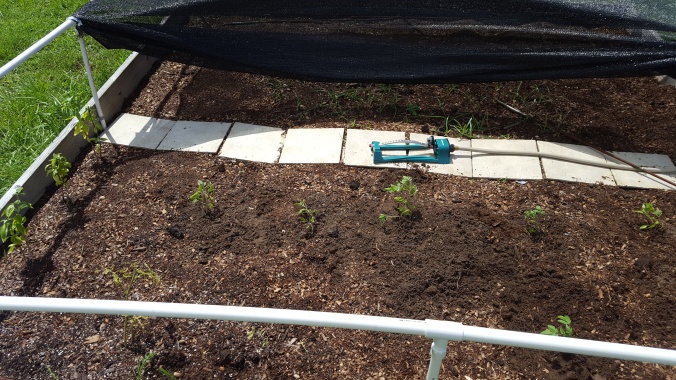
Materials- for one 10’x 10′ shade cover
When we moved into our new place in July there were 4 large raised garden beds completely overgrown with weeds.
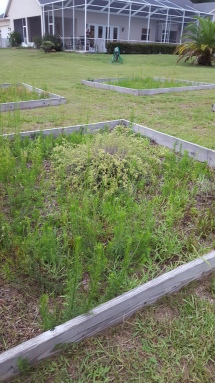
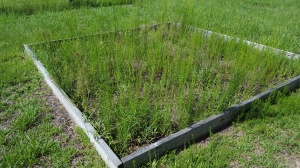
Clearing out the weeds is taking a while for two reasons. Mostly it is just too hot and humid to work outside for long. Plus as soon as I get a spot cleared and turn to work on the next area, the previous one starts sprouting new weeds! It is a process, but I’m making progress!
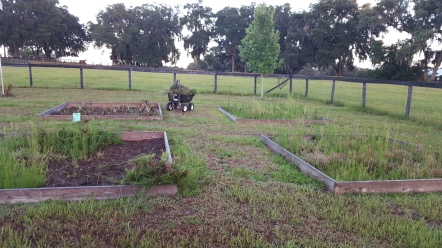
I was pleasantly surprised to find that underneath the weeds, the soil was actually pretty decent. At some point in the past someone must have supplemented it because its not the sandy stuff we have in the yard.But the soil level was pretty low in the shallow raised beds so I bought a trailer load of good, organic garden mix to mix in.

in the meantime, I started some seeds on the porch where I could keep them out of the direct sun and keep them watered. I planted 4 types of tomatoes and jalapenos. They did great and I had to move some to larger pots because they grew faster than my garden prep progressed.

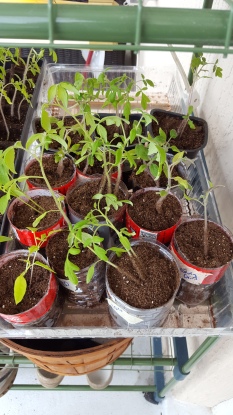
Finally I had one of the beds ready and I eagerly filled it with my little tomato plants.
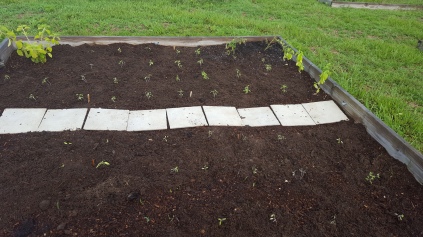
2 days later they were all dead! This Florida sun is harsh! Thankfully I had saved out some of the best plants, just in case. I quickly ordered some shade cloth and picked up a bunch of PVC piping from the hardware store to make a shade cover.
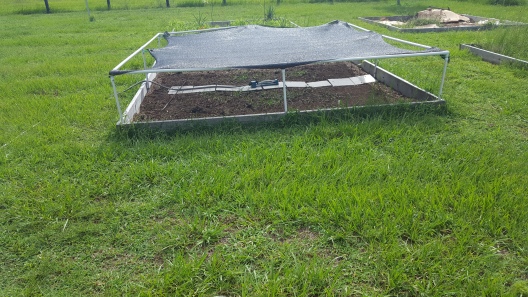
I’ve just planted half of the remaining plants so cross your fingers that they won’t die this time. I did save some of them in case my shade cover doesn’t work. It only blocks about 40% of the sun so if they still get fried I will try putting a second layer on top. Now that the support is built it should be easy to toss something else over top if needed. Hopefully I’ll be able to use it in the winter with a different cover to keep warmth in on the few nights when it gets cold enough to frost. For a post on how I made the shade cover, click here.
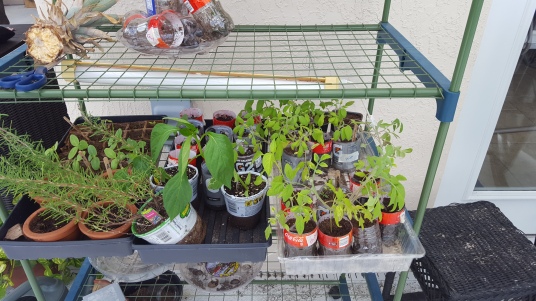
I’ve also started some cucumbers peas and herbs and picked up a couple of bell peppers from the store (mine didn’t germinate this year). The peppers will go into the same bed as the tomatoes once the shade has proven successful. The other seedlings need to grow a bit more before transplanting and then they will go into the second bed once its ready!
Alternate title: 12 Empty Acres
Alternate title: The Dangers of Perilla Mint
I’ve been putting off writing this post. I’ve started it several times, but its hard to find the right words. And honestly its not something I want to talk- or even think- about. But it is time to share what has happened and hopefully by posting all the information here I can avoid having to explain what has happened over and over for different people. You see, over the last three weeks – since soon after we moved- every time someone asks me “How is the flock settling in?” I lie and say they are doing fine. But they aren’t. In fact, most of them aren’t alive anymore.
Let me go back to the beginning. At the end of June we moved, family and flock, from KY to FL. Our new farm was carefully chosen for its 12 acres of beautiful grassy fenced off pasture. Unlike our last farm, this pasture is mostly grass with only a bit of brushy/weedy areas around the fence line. They had been keeping horses on it and all the neighboring properties with similar pasture are full of beautiful -and expensive- thoroughbred horses. I assumed that if it was safe for them then my little flock of sheep would do just fine. We hired a livestock transport guy to load the flock in KY and deliver them to their new home in FL on June 30th. Everyone made the journey fine and after unloading we watched them explore. They had never been in such large pastures and it was amusing to watch them travel through the tall grasses, tasting the new (to them) plants as they went. As a rule, sheep and goats don’t usually die from toxic plants because of their grazing habits. They tend to sample small bites of this and that and if something makes them feel bad or tastes funny they won’t eat anymore. Generally, poisonous plants don’t taste good to them so after a bite or two they move on (the exception being Azaleas which are both delicious and deadly). I was more worried about the heat, unknown local predators or them finding a weak spot in the fencing than I was about what they were eating.
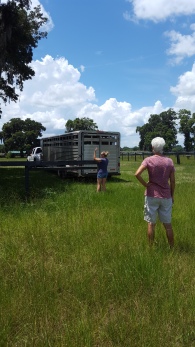
On the morning of July 11th, when I went out to check the flock’s water, I stumbled across a dead lamb. And then I realized that only a few sheep were heading towards me -usually the whole flock comes running for treats. My stomach sank. Lily was clearly agitated and – unusually- alone without her two ram lambs. I let Lily guide me and she took me to where one of her lambs was dead in the grass. Following Lily around the pasture I soon found three ewes and three more lambs. Overnight, without any warning, we had lost Etta, Kelly, Liisu, Nimo, Nosi, Nuku and Natalie.
Unable to speak and barely able to see through my tears I texted Chris “I don’t know what to do. What do I do?” But once I calmed down I realized that something had to be done, and quickly. We had lost 7 sheep but we had 5 left, plus Ivy and Grace. Whatever had killed half my flock was still out there. I needed to do something to protect the rest, if I could. I put in a few calls to local vets and soon was put in touch with Dr. Jimenez at the University of Florida vet school. We discussed taking one of the bodies to the state lab for a necropsy and toxicology testing but decided that it would take too long to get results from toxicology to help the rest of the flock (they needed action taken NOW, not in a few weeks when the lab results were back) and that by the time I got one of the bodies down to the state lab a few hours away it would probably be decomposed past the point of doing any good. Instead, Dr Jimenez grabbed a few of her veterinary students and came down to the farm to see what could be done.
Dr. Jimenez and her students performed a necropsy (the animal version of an autopsy) on Nosi’s body out in the field. It was immediately apparent that something was wrong with his respiratory system. The lungs had damaged areas and large blood clots were found throughout the throat. His digestive system (always a delicate area in sheep) was fine and I was pleased to hear that there was no sign of parasites since that is a big problem in ruminants. It was clear that whatever killed Nosi – and the rest of the flock – had affected his lungs/respiratory system. After the necropsy, Dr Jimenez and her students walked through the pasture to see if they could find the culprit. Very soon, she stopped at an area of overgrown weeds along the fence line and identified our killer: Perilla Mint.
Perilla Mint, or Shiso, is – as its name indicates- a member of the mint family. It smells minty, has a square, bumpy stem and small purple flowers. Though a culinary herb for humans it is deadly to all ruminants. Apparently it is toxic to horses but horse don’t usually like to eat it, so it has been allowed to grow and spread out here in horse country. Unfortunately, my flock decided it was delicious. I later discovered evidence that they hadn’t just been eating it where it was mixed in with the grass they were grazing- they were actively seeking it out and eating it with preference over the nice, healthy grass filling the pasture.
After identifying the problem, I walked through the rest of the property and found that one of the front pastures only contained a few small patches which I could quickly pull/dig out. While Chris dug a big hole for half the flock to be buried in I moved the rest of the flock to the safer pasture.
 A few days later Leo succumbed, followed shortly by his brother Larry. A week later we lost Kaylee. We aren’t sure if these deaths were due to damage caused before we moved them to the front pasture or whether they found more perilla that we hadn’t caught. As of today- July 28- only Lily, Nigel (one of the ram lambs), Ivy and Grace remain. Two days ago we noticed Nigel limping and discovered that his thick wooly behind had attracted flies and he was suffering from a case of fly strike. I won’t go into details because its gross but we got him cleaned up and on antibiotics and so far he seems to be recovering. It has been almost a week since our last loss and we are hopeful that this is the end. If Nigel and Lily survive another week we will be sending them to NC to live at my parents’ farm (where Francine, Elizabeth and her two ewe lambs from this spring already are- thank goodness). Florida isn’t an ideal place for Shetland sheep with their heavy wool coats and they will be more comfortable in NC. The flock will continue up there and we already have some plans for preserving some of our flock genetics with Elizabeth and her two girls and Nigel (who thankfully we kept intact). Lily was a newcomer to the flock, only added a year ago, but she has such a sweet personality and exceptionally fine fleece that we are very thankful that she has survived.Cross your fingers that these two sheep make it to August 6, when my parents are coming down to rescue them.
A few days later Leo succumbed, followed shortly by his brother Larry. A week later we lost Kaylee. We aren’t sure if these deaths were due to damage caused before we moved them to the front pasture or whether they found more perilla that we hadn’t caught. As of today- July 28- only Lily, Nigel (one of the ram lambs), Ivy and Grace remain. Two days ago we noticed Nigel limping and discovered that his thick wooly behind had attracted flies and he was suffering from a case of fly strike. I won’t go into details because its gross but we got him cleaned up and on antibiotics and so far he seems to be recovering. It has been almost a week since our last loss and we are hopeful that this is the end. If Nigel and Lily survive another week we will be sending them to NC to live at my parents’ farm (where Francine, Elizabeth and her two ewe lambs from this spring already are- thank goodness). Florida isn’t an ideal place for Shetland sheep with their heavy wool coats and they will be more comfortable in NC. The flock will continue up there and we already have some plans for preserving some of our flock genetics with Elizabeth and her two girls and Nigel (who thankfully we kept intact). Lily was a newcomer to the flock, only added a year ago, but she has such a sweet personality and exceptionally fine fleece that we are very thankful that she has survived.Cross your fingers that these two sheep make it to August 6, when my parents are coming down to rescue them.
We will keep Grace and Ivy on the farm. They are better adapted to the hot weather than the wooly sheep and so far don’t seem to be suffering from the perilla or the flies. Of course, they will be restricted to the front pasture until the rest of the property has been cleared of perilla.
Once we get the perilla mint removed from the property we will be starting over. I’m not sure what our new flock is going to look like. I’ve heard good things about Gulf Coast Native sheep but I’m not sure if my heart is ready to become invested in wool sheep again just yet. Since we already know how to raise sheep and goats I’m considering giving meat sheep and/or goats a try. There are breeds better suited to this climate and an ethnic market for the meat. Once we get rid of the toxic plants our only problem should be internal parasites (worms) which love the hot, damp weather but we have enough pasture that we can rotate the flock to keep the worms under control.
We’d also like to add a small dairy cow to provide milk/cheese for the family and perhaps get a meat calf to keep her company and raise to market weight.
For now we are still coming to terms with our losses (both emotional and financial), researching how best to deal with the perilla mint and beginning to make plans for the future.
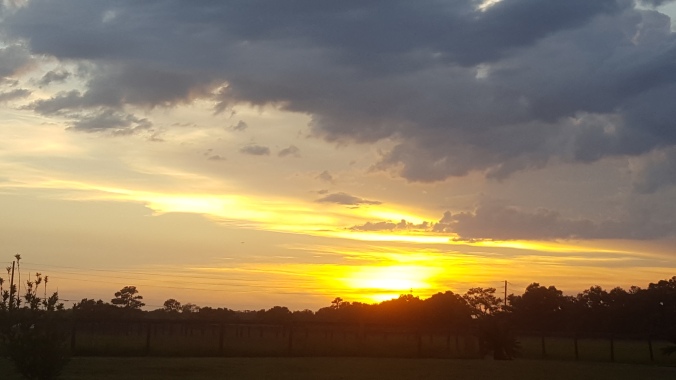
The sun setting as we finished burying sheep on the day of our biggest loss.